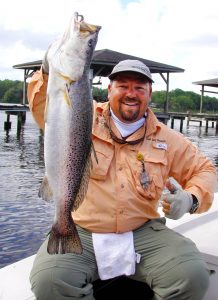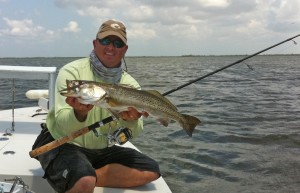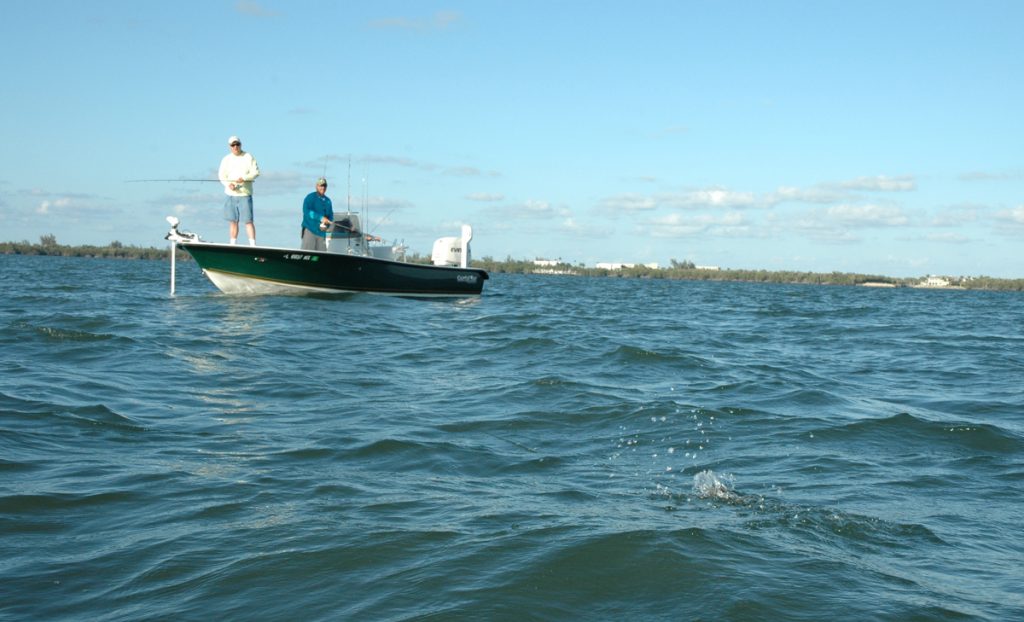February 08, 2013
By Chris Christian
You'll catch more trout weighing over five pounds on purpose than by accident.
 Spring is right around the corner, and with it the rising appetites of monster trout like this one caught by Indian River Lagoon guide Capt. Ed Zyak.
Spring is right around the corner, and with it the rising appetites of monster trout like this one caught by Indian River Lagoon guide Capt. Ed Zyak.
You're certainly not alone. Given that seatrout are among the most popular coastal fish in Florida, and that they're capable of growing to 17 pounds or more, it might strike an outsider as unusual that most anglers seldom catch the big ones. So here are a few key things to know if you want to go fishing for big seatrout.
An obvious reason is that there are a lot more of the smaller school trout than there are the “gators,” so named for their long frame and gaping, toothy maw.
The less obvious reason is that gator trout are a different animal. They don't behave the same way as school trout, or inhabit the same areas. Many anglers who go “trout fishing” are using tactics tailored to schoolies. It can be tough to leave a good bite, but if you're into a bunch of slot-size fish, 15 to 20 inches, don't expect bigger trout to be around. Those smaller trout won't feed with the gators because the big trout will eat them. There may be bigger trout in the general area, but seldom with the schoolies.
You also won't find gators in schools. Much of the time they will be loners, although on rare occasions I have seen groups that I thought might have had a dozen fish in them. Pairs are also somewhat common.
Those big trout will also roam a long way and sometimes wind up in extremely shallow water. But, under most circumstances, regardless of how shallow they are holding, they won't be more than a couple of tail flips from the deepest water in the immediate area.
The scattered nature of big trout makes lures that can cover a lot of water a more effective tool than live bait that sits in one place. During the three decades I've been chasing gators in Florida I do not remember a single one caught on live bait, and the many guides I've talked to agree. The record book tells the same story: the IGFA All-Tackle World Record, 17 pounds, 7 ounces, was in fact caught on a Zara Spook. Lures are simply more effective. Those include topwater plugs, and leadhead jigs with a soft plastic (4- to 5-inch swimming) tail. One of the deadliest lures, however, is a sub-surface jerkbait, either hard or soft plastic. I've seen many times when big trout would blow up on a topwater plug, but not take it—and then eat the subsurface jerkbait I followed up with.
Savvy anglers will carry three rods: rigged with a topwater, jerkbait and jig. And, they won't hesitate to shift between them. It also helps if you're in areas that produce big trout, and here are five of the best in Florida.
First Coast
Stretching from Fernandina to St. Augustine, and flanked by the Mayport and St. Augustine inlets, the First Coast offers a maze of deep channels, strong tides, side creeks and back bays. It's one of the top spots in Florida to catch a gator trout.
It's also a lot of water to cover, but you can cull much of it out. The vast majority of 5-pound-plus trout are caught within five miles inside either inlet. And, during two specific periods—April through June, and October and November. Picking the right spots can narrow it further.
“I want to stay in big water; the main river and ICW,” says Capt. Tony Bozzella, who operates TBS Charters from Jacksonville and teaches at Florida Sportsman Expos. “If I'm looking for big trout I don't expect to find many of them in the shallow back creeks.”
“What I'm looking for,” says Bozzella (whose guide trip log books over the last 48 months show 96 trout between 5 and 11 pounds) “is a narrow shoreline shelf, whether it's a spartina grass line or docks, that drops quickly to seven feet or more, and combined with moving water and the presence of baitfish, on the top end of the tide. If I can get this early or late with dimmer light, I prefer it. But, I have caught 9-pound trout at midday with the same conditions.”
Key areas in Jacksonville are the Fort Caroline shoreline, the Blount Island area, and right downtown in Arlington, around the industrial parks. In St. Augustine, the key areas are from the inlet north to Casa Cola Creek, and south to below the 312 bridge.
There are two exceptions to the “big water” rule. In Jacksonville it's Mill Cove—a large, shallow, oyster-laden bay close to the inlet. A rising tide will flood the spartina grass lining the back shoreline. If baitfish are pushed back into it, big trout will go very shallow. A trip I made there in August resulted in a 7.5-pound trout on a topwater plug at noon—in three feet of water.
In St. Augustine the exception is Salt Run. This is a narrow tidal bay right next to the inlet. If pogies are there in the spring, or mullet in the fall, big trout will also be there. In my own travels, I've seen this area produce more 6- to 10-pound trout than any other area in St. Augustine.
Mosquito Lagoon
Moving south along the east coast, this is another top producer that offers a wide variety of terrain. Captain Scott Tripp, who operates New Smyrna Outfitters in New Smyrna Beach, divides it into two distinct areas. Which he chooses depends upon the season.
“During winter and early spring the grassflats in the Lagoon are the best bet,” he says. “The key flats are those that have deeper channels on their outer edge.”
 Grassflats with deep outer edges are key spots in Mosquito Lagoon, especially in early spring. Below: A lean, mean mullet-eatin' machine from Steinhatchee.
Grassflats with deep outer edges are key spots in Mosquito Lagoon, especially in early spring. Below: A lean, mean mullet-eatin' machine from Steinhatchee.
Cooler weather will see the big trout (Tripp notes that numerous fish to 9 pounds have been taken in recent years) come out of the channels and move well up onto the flats, where white sand holes form prime ambush points. Once the weather starts to warm in the spring the movements to the flats become shorter,
and may be over by midmorning. The channel drops on the outer edges now become prime holding areas. Once summer sets in, Tripp shifts northward.
“The area from Turtle Mound north to the SR 44 causeway sees more tidal action and has deeper water
than the Lagoon,” Tripp notes, “and while you can catch big trout in this tidal area year-round, it's at its best in the summer.”
This area is a maze of channels, shallow bays and side creeks. The normal tide range is about two feet. On a rising tide, especially early in the day, Tripp will push into the back bays and creeks. Topwater plugs (like the 3.5-inch Rapala Skitterwalk) are effective choices. The falling tide, however, is often a better bet.
“Sharp drops in the main channel near a creekmouth, especially if there is oyster present, are prime spots when the tide drops,” says Tripp. “And, it really doesn't matter what time of day it is.”
Hard plastic jerkbaits are deadly on these drops, and one June outing with Tripp produced a 5- and a 7.5-pound trout at midday.
 Capt. Tony Bozzella docks a double-digit seatrout on the St. Johns River.
Capt. Tony Bozzella docks a double-digit seatrout on the St. Johns River.
Steinhatchee
The Gulf side of the state doesn't seem to produce as many big trout as the Atlantic side, but there are still gators to be found. Captain Danny Allen, who operates Southern Salt Charters from his home in Chiefland, rates Steinhatchee as a best bet in the Big Bend.
“A lot of anglers think of the Steinhatchee River as a place to catch trout during the winter when they stack up in the deep holes,” Allen notes. “But the best time to catch big trout is in March and April, and again in October and November.
These transitional periods bring the big trout out of the ‘airboat holes' and put them in reach of kicker boats.”
Once those gators start to move, their movements are predictable. Tide levels in this area may only be a couple of feet, but at the peak of the rising tide the trout will be in the lower reaches of the maze of small creeks north and south of the Steinhatchee. During the lower portions of the tide they will be on the flats within a mile or so of those creeks. They are following the baitfish and the rising water. Key areas are around Rocky Creek, and the creeks inside of Nine Mile Bank.
“On the low end of the tide,” Allen says, “I'll be looking for hard shell mop grass sand holes on the flats within a mile of the creekmouths. Those holes may only be three feet across, but they may have a 28-inch trout laying across it. I sight fish these with a white Berkley Gulp! shrimp on a jighead.”
As the water rises the fish follow the bait toward the creeks. Allen stays with them by finding the bait and the sand holes. Once they get into the creeks, he may shift to topwater plugs or shallow jerkbaits and concentrates on any sharper drop, especially along oyster bars.
It's a simple approach, but produces 8-pound trout every year.
Charlotte Harbor
The Gulf has always been known for good numbers of trout, but not a lot of big ones. However, some areas can get hot. Right now, Charlotte Harbor is very hot!
“During the last two or three winter and spring periods it has become very common to catch 4- to 6-pound trout,” says Capt. Danny Latham, who operates Reel Fishing Charters in Punta Gorda.
“I've lost count of those. But, last year I did have 17 trout between 8 and 9 pounds.”
Those trout can show up in a number of locales within Charlotte Harbor and nearby Pine Island Sound, but Latham has a specific plan for his success.
 Low tide finds Capt. Danny Latham fishing soft baits over mottled bottom for Charlotte Harbor's spring gators.
Low tide finds Capt. Danny Latham fishing soft baits over mottled bottom for Charlotte Harbor's spring gators.
“The Gasparilla and Pine Island Sound areas are very productive,” he notes. “Within that area I want to find a grassflat that has a mottled bottom with a lot of sand holes; that has a couple of feet of water over it at the start of the incoming tide; and abuts a channel or drop that has four to six feet of water in it. Deeper is better.”
On the dead low tide those trout are tucked into deeper water. The first portionof the rising tide starts them moving. Latham likes that situation because those trout haven't yet moved far and are more easily located as they come out of deeper water to the flats.
Latham favors a MirrOlure Lil' John soft plastic bait on a light jighead, or a MirrOLure Mirrodine shallow running plug, for working those sand holes.
“Those cast a long way and I don't want to get real close to these trout. They can be a little spooky when they first come out of that deeper water and onto the flats,” he says.
It's a distinct depth, tide and terrain pattern, but it pays off for Latham.
Lower Indian River Lagoon Okay, that 17-pound, 7-ounce IGFA record...it was caught on the Indian River
Lagoon in Fort Pierce, Florida's central east coast. In all likelihood, the next one will be, too.
The Indian River, or IRL, has some unique attributes which produce gator seatrout, and in this part of the state, the term “gator” is usually reserved for trout approaching 10 pounds. Several fish this size are landed in the region each year.
 Short-pants winters on the southernmost Indian River Lagoon mean anytime prospects for big trout.
Short-pants winters on the southernmost Indian River Lagoon mean anytime prospects for big trout.
So is it a river or is it a lagoon? A little of both, but more of lagoon—most of the water interchange is the result of ocean tides, as opposed to freshwater flow. Several deep inlets, from Jupiter to Ponce de Leon, pierce the barrier island, bringing salty waters and a huge variety of baitfish and gamefish into the 150-mile IRL. The Intracoastal Waterway runs straight up the middle.
Mosquito Lagoon, which we discussed already, is often considered the northern reach of the IRL, sharing similar ecological and geological characteristics with the rest of the waterway. However, there's a key difference in climate. Freezing weather in January and February is quite common in New Smyrna Beach, while Jupiter, at the southern end of the IRL, is closer to tropical.
Captain Ed Zyak, a light tackle guide in Jensen Beach, focuses on the southern end of the Lagoon. Here, the warm Gulf Stream current a few miles offshore acts as a radiator, keeping coastal water temps moderate though the year.
“Adult seatrout are primarily finfish feeders, and in the Lagoon they eat baitfish
year-round,” he said. “I'll talk to friends on the Gulf coast, in winter, and they're water temp might be in the 50s, while over here it's in the 60s.”
“My favorite time for big trout is from mid April through early June—more baitfish are moving into the estuary, the fish suddenly get more aggressive on topwater baits.”
At that time of the year, Zyak looks for the biggest fish in shallow water, 1½ to 3 feet, often on bottom
that's a mix of seagrass and sandy potholes. Casting large topwater plugs, such as the big Top Dog and He Dog MirrOlures is effective, but so is fishing subsurface plastics, such as jigs with paddle tails, or molded shrimp. Zyak and other IRL pros sometimes find the biggest trout feeding at midday, which anglers
from other parts may find surprising.
“I look for out-of-the-way spots. In winter, when the water's clear, I'll do some scouting after guide trips, looking for those little pieces of bottom, spots no one really fishes.”
Zyak fishes out of a 22-foot Kenner bayboat, but also has a Gheenoe for accessing extreme shallows and tuck-away spots—“places that aren't really even on charts,” he said.
Then again, some of the places Zyak fishes are so obvious anglers simply pass them by, as was the case on one hot July afternoon when he hauled up a 12.9-pounder for the September 2005 cover of Florida Sportsman magazine. FS
First Published Florida Sportsman Magazine, Feb. 2012.
Click Here to Have Florida Sportsman Delivered to Your Door.

